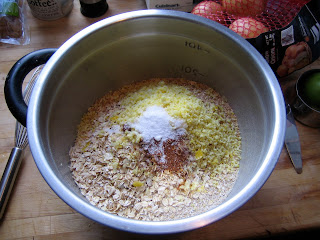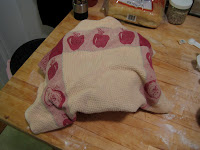
Last Saturday I made rice pilaf, and tuna-stuffed cherry peppers. The pilaf was ok, but the flavor was so much mellower than the Big Wow Mouthful that came from the cherry peppers that I wouldn't pair them up again. The pilaf was very soothing, but it just couldn't keep up with the peppers. Something more acidic, like a salad with a vinaigrette, is called for here.
On Wednesday, I brought some of the leftover cherry peppers to work for lunch. And half-way through lunch, I noticed something interesting. During most lunch hours, I just shovel away until I feel full, have another bite or two, and go back to whatever I was doing. This is why I used to be convinced that there's no way that Mediterranean diets would work for most Americans: we're just used to high volume, and almost-good-enough quality. So, we shovel away, while we go on with our lives. No wonder we all talk with our mouths full.
But I wasn't doing that with the stuffed peppers. Individiually, each stuffed pepper isn't a mouth-filler in terms of volume. But between the sweet and spicy peppers, the tuna, the turmeric, and the balsamic, there's a lot of flavor going on, so it's actually more enjoyable to eat only one at a time, at a more relaxed pace. As a result I found myself enjoying my lunchtime more slowly, and in a more contemplative mood. This was a much different kind of experience for me, and it's setting the bar, I think, for what to look for in a meal, and in a recipe.
I'll be making these again, but this time I'll be making them to bring in for lunch... for a week.
This recipe was adapted from the version published by Eating Well, which called for capers instead of turmeric.
Ingredients for stuffed cherry peppers:
-2, 16 oz jars of peppadew peppers.
-3 cans of white albacore tuna in water
-Extra Virgin Olive Oil
-Fresh lemon juice.
-Fresh lime juice. (optional)
-Turmeric
-Balsamic vinegar.
Peppadew peppers: Trader Joe's has them, Whole Foods has them. I'm sure other stores have them, too... typically near the olives. I got some from Whole foods that morning, and went back to TJs to get more later on. Whole Foods cost twice as much, but the peppers were a lot less squishy, and easier to stuff, so it's a draw, really.
To prepare the tuna for stuffing into the peppers, you mix it with the olive oil, lemon juice, and turmeric. I'd never really worked with turmeric before. I know that it's one of the spices that make up curry as we know it, but it was still new to me. The first thing worth mentioning is that it will stain anything yellow. So don't make more of a mess than you have to. It has its own flavor, and there's definitely a threshold where it's just overpowering. So, I spent some of Saturday afternoon experimenting with proportions.
I think it's worth doing the experimenting to see just what your own taste buds are ok with. Even more turmeric started to make the tuna taste less fishy, which I liked, but the flavor from the spice was simply overpowering. It's also worth doing the experiments with the peppadew peppers on hand: the combined flavors can be interesting. I kept half of a lime on-hand that I would lick in between tastings to clear my palate, so that I could taste the differences. I had to... after a while, everything just tasted like EVOO and turmeric, and it was hard to tell the differences between the different mixes.
What I came up with, I think, was something close to 3 tbsp of EVOO, 2 tbsp of lemon juice, 1 tbsp of lime juice, and 1.5 tbsp of turmeric. Combine this mixture in a bowl with the tuna, and mix it up with a fork.
There's not much preparation that needs to be done to the peppers, just strain them. I set the steamer into one of my sauce pans to catch all of the brine from the jar. Not every pepper is going to be physically intact enough to be stuffed, and this way I was able to put the brine back in the jar with the leftover peppers, to be used in something else. And the steamer worked well enough as a work bowl, so I could sort through what was there, instead of fishing them out of the jar.
While I know it should go unsaid that you should wash your hands before cooking just about anything, this is one of those times when you're really going to be touching pretty much everything... you'll be holding a pepper in one hand, and using a combination of fork and finger to push the tuna into the peppers. Clean fingers are critical.
I used a casserole dish to hold the peppers after they'd been stuffed.
The last step was to pour about 1/4 cup of balsamic into a pan of some kind, and simmer it down for a while, until there's about 2 tbsp worth of balsamic glaze. I used more, and reduced it further. What I ended up with was basically caramel in consistency. I did the reducing in the afternoon, put the result in a small glass bottle, and put it into the fridge. I had to microwave the bottle to get the glaze to pour out.
Pour the glaze over the prepared peppers. And enjoy... slowly.


















































